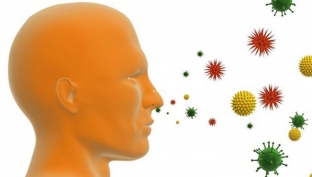Allergic rhinitis is a disease that is manifested by sneezing, itching in the nose, rhinorrhea, and these characteristic symptoms occur immediately after contact with the allergen. Symptoms may disappear on their own if contact with the allergen is eliminated, or require appropriate, individually tailored treatment. The development of allergic rhinitis is accompanied by characteristic symptoms that allow the doctor to prescribe treatment as soon as possible and alleviate the patient's condition.
The causes of allergic rhinitis and the main types
Allergens that cause the development of allergic rhinitis or its exacerbation are usually divided into two large groups – external and internal. External allergens usually include flower pollen, which is scattered from trees, weeds and grasses, as well as spores of mold fungi such as Alternaria or Cladosporium.
The group of indoor allergens that provoke the development of allergic rhinitis is much more extensive. It includes:
- house dust mites,
- library dust,
- Mould fungal pores such as Penicillum, Aspergillum,
- the secret of warm-blooded domestic animals (hair of cats, dogs),
- the secret of certain insect species (cockroaches),
- dry food for aquarium fish.
Under the influence of certain allergens, an inflammatory process develops in the mucous membrane of the nasal cavity.
The nature of allergic inflammation and its duration depend on the level of concentration of allergens in the environment.
When it comes to external allergens, then usually the doctor deals with the seasonal development of allergic rhinitis or its exacerbation. Usually the concentration of pollen and microfungi in the air rises in spring and late autumn, causing allergic inflammation. This type of allergic rhinitis often resolves on its own as the causative allergen gradually ceases to be effective. When the allergen is constantly exposed (for example, house dust or mold), allergic inflammation persists without stopping.

How does allergic rhinitis develop
The development of allergic rhinitis is manifested by a characteristic clinical picture, where there are three groups of symptoms – basic, additional and general non-specific. The combination of these symptoms greatly facilitates the diagnosis of the condition.
The main symptoms of allergic rhinitis include watery discharge from the nose (rhinorrhea), paroxysmal sneezing (most often in the morning), itching or burning in the nose, and characteristic mouth breathing due to nasal congestion. Perhaps a change in the timbre of the voice, a decrease in the sense of smell, the occurrence of a night & nbsp; snoring. A characteristic sign of the development of allergic rhinitis – the so-called allergic salute, when the patient constantly scratches his nose with the movement of his palm from the bottom up.
Additional symptoms that help the doctor make a diagnosis of allergic rhinitis are:
- inflamed skin above the upper lip and on the wings of the nose,
- cough and sore throat,
- nosebleeds due to frequent blowing of the nose,
- dark circles under the eyes due to venous congestion due to swelling of the mucosa of the paranasal sinuses,
- pain in the ears when swallowing.
Another specific additional symptom of the development of allergic rhinitis – inflamed eyes, patient complaints of photophobia, itching and lacrimation.
Common non-specific symptoms of allergic rhinitis are irritability and headaches, increased fatigue and inability to concentrate on work, loss of appetite, depressed mood, sleep disturbance.
The treatment of allergic rhinitis is aimed primarily at improving the patient's quality of life by relieving the most severe symptoms, as well as preventing the development of bronchial asthma. Therapy should be complex: eliminate the allergen, prescribe symptomatic and, if necessary, basic anti-inflammatory therapy, select a hypoallergenic diet, prescribe immunotherapy with a causally significant allergen.







Add a comment